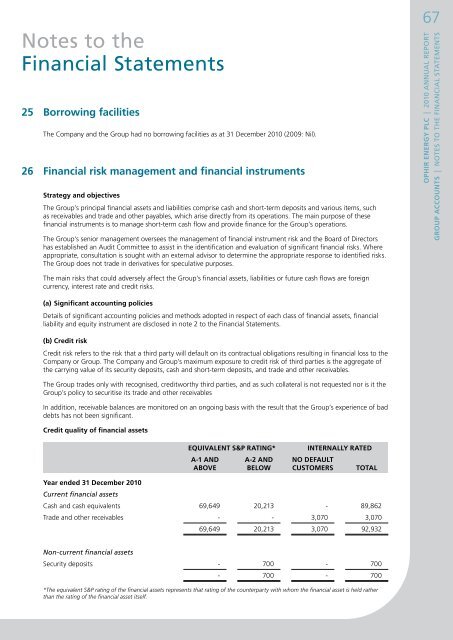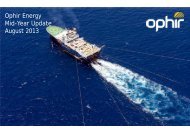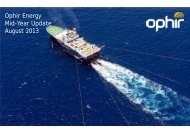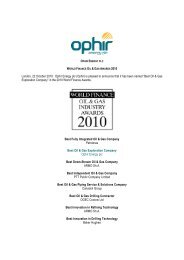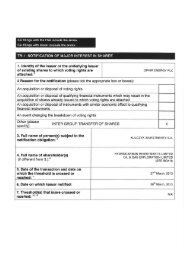Annual Report 2010 - Ophir Energy
Annual Report 2010 - Ophir Energy
Annual Report 2010 - Ophir Energy
You also want an ePaper? Increase the reach of your titles
YUMPU automatically turns print PDFs into web optimized ePapers that Google loves.
Notes to the<br />
Financial Statements<br />
25 Borrowing facilities<br />
The Company and the Group had no borrowing facilities as at 31 December <strong>2010</strong> (2009: Nil).<br />
26 Financial risk management and financial instruments<br />
Strategy and objectives<br />
The Group’s principal financial assets and liabilities comprise cash and short-term deposits and various items, such<br />
as receivables and trade and other payables, which arise directly from its operations. The main purpose of these<br />
financial instruments is to manage short-term cash flow and provide finance for the Group’s operations.<br />
The Group’s senior management oversees the management of financial instrument risk and the Board of Directors<br />
has established an Audit Committee to assist in the identification and evaluation of significant financial risks. Where<br />
appropriate, consultation is sought with an external advisor to determine the appropriate response to identified risks.<br />
The Group does not trade in derivatives for speculative purposes.<br />
67<br />
<strong>Ophir</strong> energy plc | <strong>2010</strong> ANNUAL REPORT<br />
Group accounts | notes to the financial statements<br />
The main risks that could adversely affect the Group’s financial assets, liabilities or future cash flows are foreign<br />
currency, interest rate and credit risks.<br />
(a) Significant accounting policies<br />
Details of significant accounting policies and methods adopted in respect of each class of financial assets, financial<br />
liability and equity instrument are disclosed in note 2 to the Financial Statements.<br />
(b) Credit risk<br />
Credit risk refers to the risk that a third party will default on its contractual obligations resulting in financial loss to the<br />
Company or Group. The Company and Group’s maximum exposure to credit risk of third parties is the aggregate of<br />
the carrying value of its security deposits, cash and short-term deposits, and trade and other receivables.<br />
The Group trades only with recognised, creditworthy third parties, and as such collateral is not requested nor is it the<br />
Group’s policy to securitise its trade and other receivables<br />
In addition, receivable balances are monitored on an ongoing basis with the result that the Group’s experience of bad<br />
debts has not been significant.<br />
Credit quality of financial assets<br />
EQUIVALENT S&P RATING*<br />
A-1 AND<br />
ABOVE<br />
A-2 AND<br />
BELOW<br />
INTERNALLY RATED<br />
NO DEFAULT<br />
CUSTOMERS TOTAL<br />
Year ended 31 December <strong>2010</strong><br />
Current financial assets<br />
Cash and cash equivalents 69,649 20,213 - 89,862<br />
Trade and other receivables - - 3,070 3,070<br />
69,649 20,213 3,070 92,932<br />
Non-current financial assets<br />
Security deposits - 700 - 700<br />
- 700 - 700<br />
*The equivalent S&P rating of the financial assets represents that rating of the counterparty with whom the financial asset is held rather<br />
than the rating of the financial asset itself.


